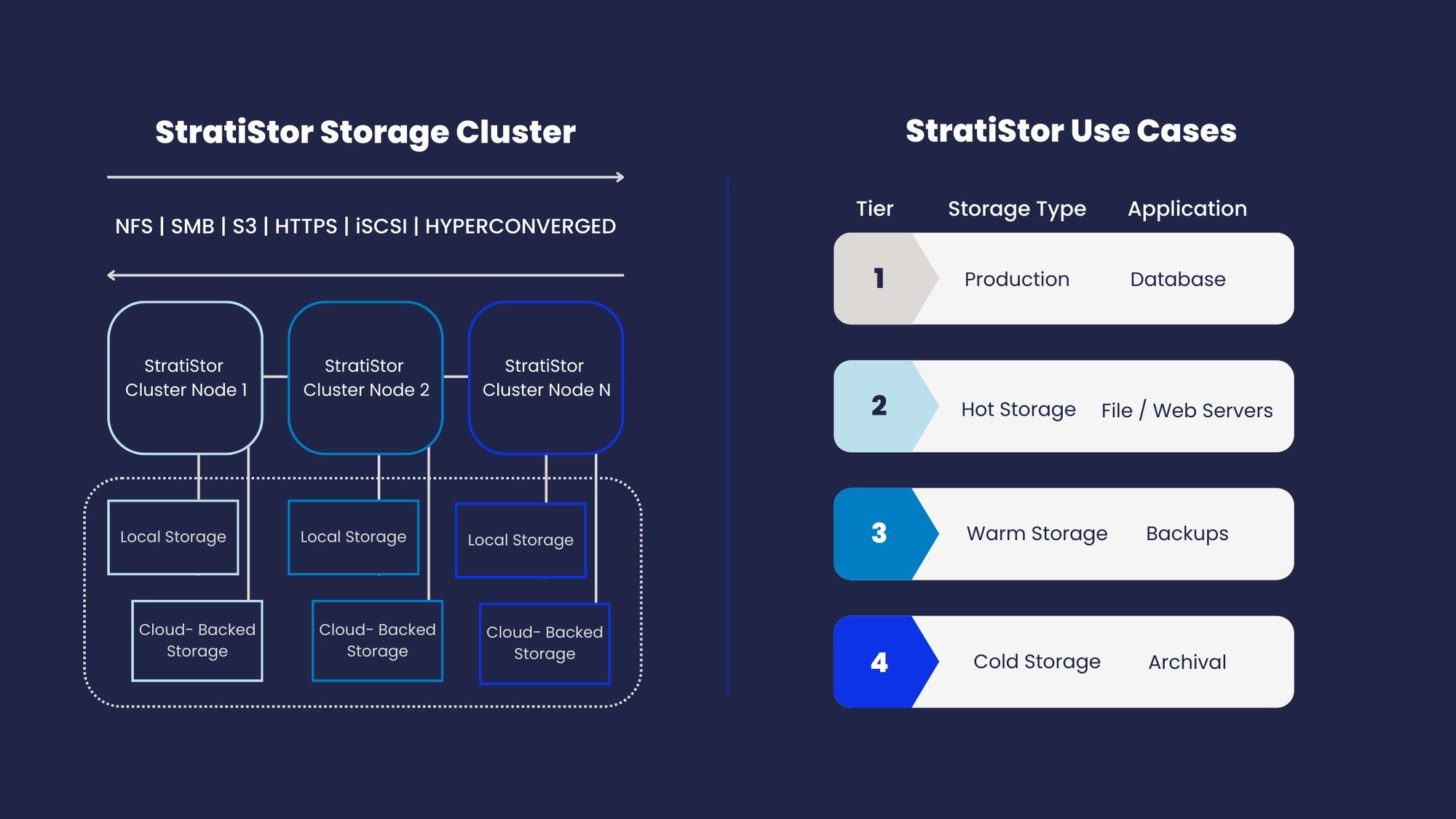Delivering secure, resilient, enterprise-class
storage across any combination of systems
Traditional storage architectures often fail to meet the demands of modern IT environments. Maximize your storage infrastructure’s potential by breaking free from traditional constraints, reducing costs, and increasing flexibility and scalability.
Complete Control Over Performance and Costs with StratiSTOR
StratiSTOR delivers enterprise-class storage services, reliability, and performance for the most demanding environments. By decoupling data from hardware, you can maximize performance and get the most out of your investments. Deploy on any combination of hardware and scale on demand, giving you complete control over performance and costs.
Introducing StratiSTOR by SteelDome
- Start small, grow as you go
- Supports hyperconvergence (VMs and containers)
- Decouples data, eliminating all hardware dependencies
- Granular, modular, and non-disruptive refresh cycle
- On demand and infinite scaling
- No data migrations
- Mix and match hardware
- AI workload ready
- Hardware Dependencies
- Vendor Lock-In
- EOL Cycles
- Data Migrations
- Capacity Issues
- Massive Initial Investments In New Hardware
- Massively Scalable
- Software-Defined
- Storage Cluster
- Enterprise-Class
Limitless Capacity
The Power of Software
Storage Cluster
A Reliable Platform

- Bare Metal
- Private Cloud
- Public Cloud
- Edge
Bare Metal
Private Cloud
environment without the need for additional hardware.
Public Cloud
overcommitted nature of public cloud resources.
Edge
Why Cluster Storage
Data Integrity Assurance: Redundancy in storage clusters guarantees data integrity by replicating data across multiple nodes, minimizing the risk of corruption or loss due to hardware failures or other disruptions.
Enhanced Data Protection: With data replicated across multiple nodes, clustered storage systems offer robust protection against data loss. Even if one node fails, the redundant copies ensure seamless access to data, maintaining business continuity.
Fault Tolerance: Redundancy provides fault tolerance, allowing storage clusters to continue functioning without disruption in the event of node failures or maintenance activities. This resilience ensures uninterrupted access to critical data and applications, minimizing downtime and maximizing productivity.
Flexible Expansion: The redundancy in storage clusters enables seamless scalability as data volumes grow. New nodes can be effortlessly integrated into the cluster, expanding storage capacity without disrupting ongoing operations. This flexibility allows businesses to adapt to changing storage requirements without costly infrastructure overhauls.
Improved Performance: As additional nodes are added to the cluster, the workload is distributed across a larger infrastructure, enhancing performance and throughput. Redundancy ensures that data is replicated efficiently across the expanded cluster, optimizing access times and reducing latency. This scalability not only accommodates growing data demands but also ensures consistent performance levels for users and applications.
Economic Efficiency: Scalability through cluster redundancy offers economic benefits by enabling organizations to incrementally increase storage capacity as needed. Rather than investing in large-scale upgrades preemptively, businesses can scale their storage infrastructure in alignment with actual usage patterns. This cost-effective approach minimizes upfront expenditures while maximizing the return on investment, making clustered storage an attractive solution for businesses of all sizes.
Continuous Availability: Fault tolerance in storage clusters ensures continuous availability of data, even in the event of server failures. With redundant copies distributed across multiple nodes, the data remains accessible through other healthy nodes, minimizing downtime and ensuring uninterrupted access for users and applications.
Resilient Data Retrieval: Each node in the cluster contains redundant copies of data, providing resilience against hardware failures or system crashes. In the event of a server failure, the data can be retrieved from other available nodes, maintaining data integrity and preserving business operations without interruption.
Enhanced Reliability: Fault tolerance mechanisms in storage clusters enhance reliability by safeguarding against single points of failure. By distributing redundant data copies across the cluster, organizations mitigate the risk of data loss or unavailability due to hardware malfunctions, ensuring business continuity and preserving critical operations
Uninterrupted Data Accessibility: Continuous operation is a hallmark of clustered storage systems, as they can withstand network outages or server failures without compromising data accessibility. When a failure occurs, remaining nodes seamlessly take over the responsibilities of the affected components, ensuring uninterrupted access to data for users and applications.
Automatic Failover: In the event of a network outage or server failure, clustered storage systems employ automatic failover mechanisms to maintain continuous operation. Redundant nodes within the cluster are ready to step in and fulfill the duties of failed components, ensuring that data remains available and services remain operational without manual intervention.
High Availability Architecture: Clustered storage architectures are designed for high availability, utilizing redundancy to distribute data across multiple nodes. This distributed nature ensures that even if individual components fail, the system as a whole remains operational, providing continuous access to data and preserving business continuity in the face of unexpected disruptions.
The Next Generation
Enterprise Storage System
StratiSTOR is a truly hardware-independent, massive-scale enterprise-grade storage platform delivering complete control and flexibility over the storage architecture, meeting the demands of intensive next generation workloads.
Download One-Pager: StratiSTOR Storage Cluster
Legacy Storage Systems
Isolated storage form islands which cannot interoperate or share data and contribute their capacity and performance independently..png?width=300&name=StratiSTOR%20(8).png)
StratiSTOR Storage Cluster
StratiSTOR forms a unified storage system which operates as a single system and scales capacity and performance linearly..png?width=300&name=StratiSTOR%20(9).png)
Learn More About StratiSTOR
Delivering the next-generation in software-defined storage technology to meet the challenges of today, and tomorrow.
